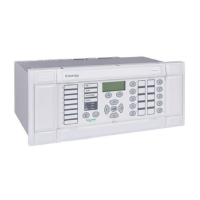Operation P54x/EN OP/La4
MiCOM P543, P544, P545 & P546
(OP) 5-117
OP
5. If no messages arrive from either end then after one second the relay will change to the
configuration that was last selected, i.e. the configuration before power down. Once
messages begin to arrive again, the relay will check them for validity against the current
scheme. If one relay is 3-ended and the other is 2-ended then the configuration will
change to 2-ended. If both are 3-ended or the same 2-ended scheme then that will
become the configuration. If two relays have different 2-ended configurations then they
are unable to determine which one to use and will each generate a configuration error
alarm and each relay will remain in its current configuration. This condition can be
cleared by restoring the relays or by removing the supply to the relay with the incorrect
configuration.
6. If all the relays in a scheme are energized simultaneously then the configuration will
revert to 3-ended if all the communication channels are healthy. This occurs because all
the relays are waiting to be told their configuration and all default to 3-ended. This is a
very unlikely event in normal use.
7. In cases where a communication channel has only half failed i.e. the receive channel
has failed but not the transmit channel, then there may be configuration errors on power
up due to the fact that the relays are not communicating correctly. If the status is
available via the third relay and healthy communications via its two channels then the
scheme will stabilize correctly.
2.2 InterMiCOM
64
introduction
Eight digital signals from local relay to the remote relay can be sent by using Programmable
InterMiCOM
64
(IM64) teleprotection available in MiCOM P54x. This teleprotection uses the
protection communication channel described in section 2.1.
In this
scheme the signaling channel is used to convey simple ON/OFF data (from a local
protection device) thereby providing some additional information to a remote device which
can be used to accelerate in-zone fault clearance and/or prevent out-of-zone tripping.
2.2.1 Definition of teleprotection commands
The de
cision to send a command is made by a local protective relay operation, and three
generic types of signal are available:
Intertripping
In intertripping (direct or transfer tripping applications), the command is not supervised at the
receiving end by any protection relay and simply causes CB operation. Since no checking of
the received signal by another protection device is performed, it is absolutely essential that
any noise on the signaling channel isn’t seen as being a valid signal. In other words, an
intertripping channel must be very secure.
Permissive
In permissive applications, tripping is only permitted when the command coincides with a
protection operation at the receiving end. Since this applies a second, independent check
before tripping, the signaling channel for permissive schemes do not have to be as secure as
for intertripping channels.
Blocking
In blocking applications, tripping is only permitted when no signal is received but a protection
operation has occurred. In other words, when a command is transmitted, the receiving end
device is blocked from operating even if a protection operation occurs. Since the signal is
used to prevent tripping, it is imperative that a signal is received whenever possible and as
quickly as possible. In other words, a blocking channel must be fast and dependable.
The requirements for the three channel types are represented pictorially in Figure 76.

